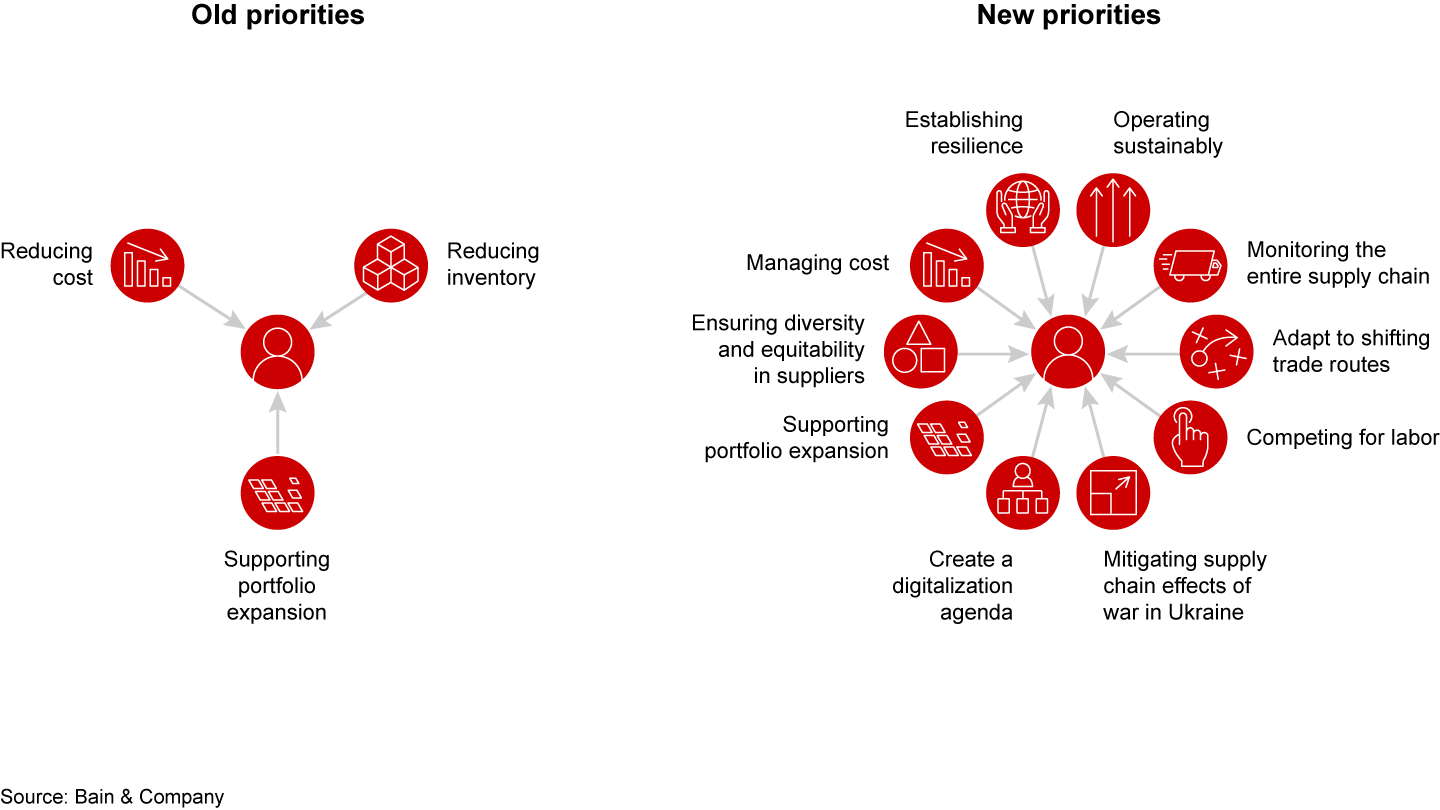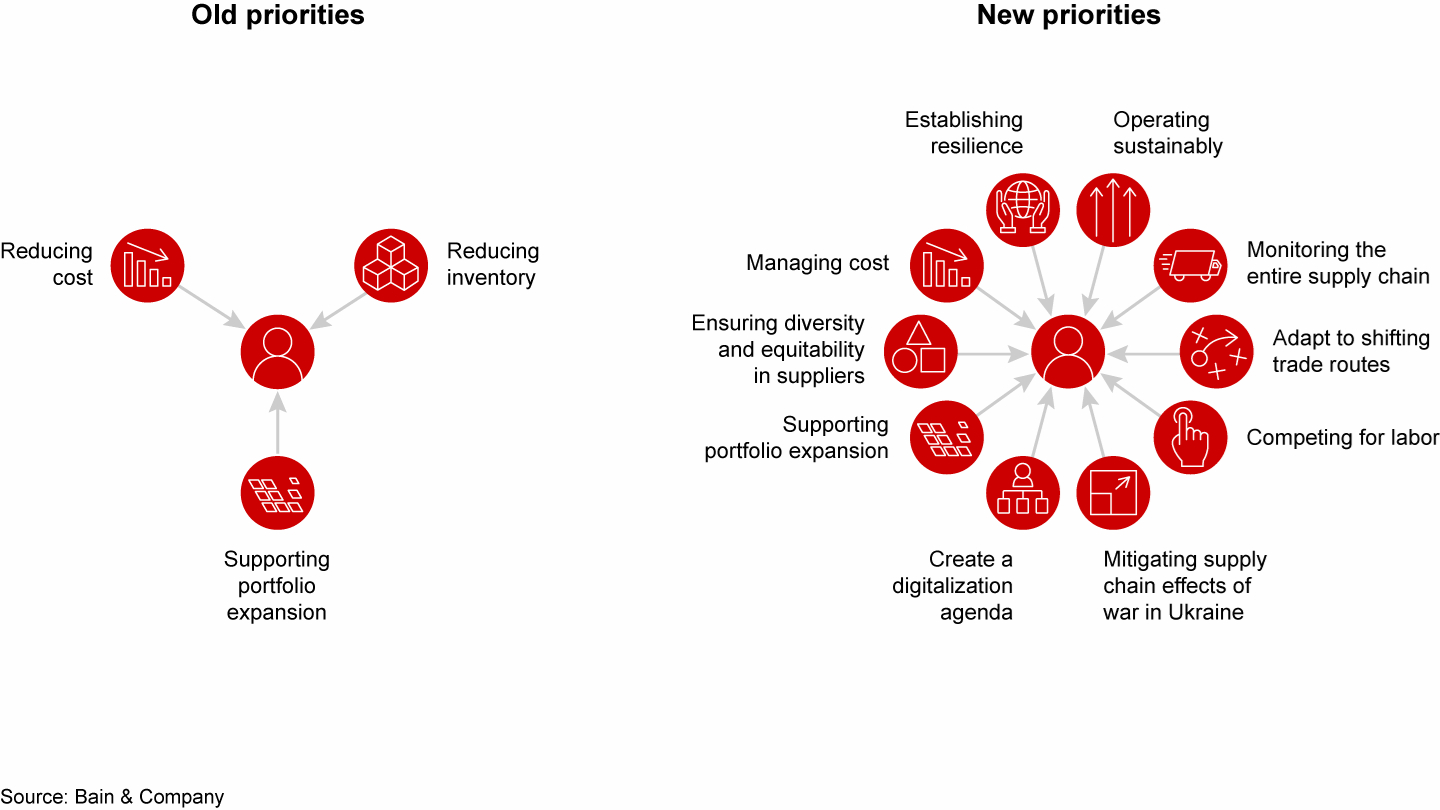Energy & Natural Resources Report

At a Glance
- Chief operating officers have never been more vital to corporate strategy—and never more visible.
- Supply chain disruptions, including those driven by the pandemic, inflation, semiconductor shortages, and war in Ukraine, have put operations in the headlines and made the COO’s role integral to corporate strategy.
- As companies pledge to reach net zero, operations teams are balancing their traditional imperatives of delivering products and services with the need to decarbonize and meet investors’ expectations about sustainability.
This article is part of Bain’s Energy and Natural Resources Report 2022
The role of the chief operations officer has always been essential, but for many years it was a low-profile role, charged with safely producing and delivering product on time and at a reasonable cost. That’s changed quickly. Over the past few years, the responsibilities and measures of success for COOs and their global operations have expanded significantly (see Figure 1). The COO’s role has become dramatically more complex as a series of global disruptions have made the role of operations chief more visible and more essential to corporate strategy.
These disruptions include Covid-19, the war in Ukraine, trade conflicts, semiconductor shortages, and inflation of commodity prices. But among operations chiefs in the energy and natural resources sectors, the most enduring and significant disruption is the energy transition and the accompanying drive to make companies and their operations more sustainable. Every day, we talk with COOs who are working to balance their traditional imperatives of delivering products and services reliably and at a price that customers can afford, along with the need to decarbonize and meet investors’ expectations about sustainability.
Every day, we talk with COOs who are working to balance their traditional imperatives of delivering products and services reliably at affordable prices, along with the need to decarbonize and meet investors’ expectations about sustainability.
The high profile of these trends and disruptions, along with their influence on the availability of consumer and business goods, means that the role of operations can no longer be taken for granted. One indicator of this is the prominence of operations topics in the media. For example, over the past two years, the number of times “supply chain” was mentioned during corporate earnings calls more than doubled, highlighting investors’ recognition of the criticality of operations. Supply chains and other operations are news.
- 151 Number of "supply chain" mentions during Fortune 500 earnings calls, Q3 2019
- 342 Number of "supply chain" mentions during those calls, Q3 2021
All of this raises the stakes for the COO and reduces the margin of error. The smallest of missteps can create disruptions that can leave business customers without the inputs they need to run their operations, and customers staring at empty shelves.
The COO's job has become much more complex


But these shifts also mean that operations can become an even more powerful competitive tool. Being a low-carbon provider, for example, can become a competitive advantage when it enables companies to charge a premium for greener products. It can also provide other benefits to buyers. When a supplier reduces its carbon footprint, its buyers can reap the benefits as they tally the upstream, Scope 3 emissions of their own production. That can become a key benefit in sales discussions, just as the lack of progress on emissions reduction or other environmental, social, and corporate governance factors can become a barrier. Increasingly, suppliers won’t make it past the RFP process unless they can attest to their own progress on issues like diversity, transparency, and emissions reductions.
Increasingly, bidders won’t make it past the RFP process unless they can show progress on issues like diversity, transparency, and emissions reductions.
How COOs are responding
COOs are doing several things to successfully navigate this changing landscape.
First, many of our COO clients tell us they’re more closely involved with setting corporate strategy than they were just a few years ago. This gives them a seat at the table and a voice in organizational decisions, including setting priorities, weighing financial trade-offs, and managing internal and external communications. This enables them to convey the possible effects on the supply chain and other operations of certain decisions before they’re made. More important, the COO is increasingly in a position to determine how quickly the company can adapt to disruptions, and also help set strategic direction that can allow the company to make the most of external conditions.
Closely related, they’re building up the capabilities they need to support effective strategic planning. Data has always been an important tool in operations, but many operations teams are doubling down on advanced analytics, which help them develop a wider range of more specific scenarios—essential for planning under uncertainty.
The COOs we talk with are also laser-focused on improving the resilience of their supply chains. In the short term, they’re assessing the risks from immediate crises like the war in Ukraine, commodities inflation, and ongoing shortages due to Covid. Getting a handle on the primary risks, based on real data rather than conjecture, allows them to create realistic scenarios so they can react quickly when they see signposts indicating where conditions are headed. This is a challenging balancing act right now. Operations teams may need to invest more to ensure a reliable supply of inputs while at the same time finding themselves under pressure to manage costs tightly against the headwinds of inflation. There’s no simple answer, and each situation requires thoughtful analysis and careful decision making.
Operations teams may need to invest more to ensure a reliable supply of inputs while also under pressure to manage costs tightly against the headwinds of inflation.
Over the longer term, ops chiefs are building resilience with a larger suite of tools, such as redesigning products and processes, finding backup and alternative sources, building capacity buffers, and continually improving logistics. A key part of resilience is just acknowledging that disruptions are happening faster and more frequently, so adaption and recovery are capabilities that need to be developed and refined. Black swan events aren’t quite as rare as they once were.